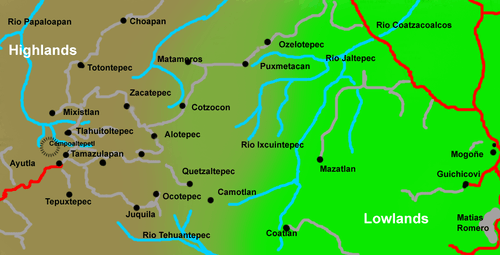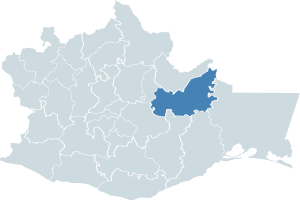Mixe people
|
The Sierra Mixe within Oaxaca, Mexico | |
| Total population | |
|---|---|
| ~90,000 | |
| Regions with significant populations | |
| Mexico (Oaxaca) | |
| Languages | |
| Mixe, Spanish, | |
| Religion | |
| Roman Catholic, and Traditional religion | |
| Related ethnic groups | |
| Zoques |
The Mixe or Mije (always pronounced ['mihe] ) is an indigenous group inhabiting the eastern highlands of the Mexican state of Oaxaca. They speak the Mixe languages which are classified in the Mixe–Zoque family, and are more culturally conservative than other indigenous groups of the region, maintaining their language to this day. A population figure of 90,000 speakers of Mixe were estimated by SIL international in 1993. The Mixe name for themselves is ayuujkjä'äy meaning "people who speak the mountain language"[1] The word "Mixe" itself is probably derived from the Nahuatl word for cloud: mīxtli.
Geography
The region where the Mixe live is known as the Sierra Mixe and is located north east of the city of Oaxaca, bordering on the Valley of Oaxaca to the southwest, the lowlands of Tehuantepec to the east, and the highlands of Choapam and the state of Veracruz to the north. The rugged and remote area is part the Sierra Madre Occidental. The western Mixe live in a mountainous temperate highland zone with the largest Mixe centers in San Pedro and Pablo Ayutla (in Mixe called Tu'ukyom[2]), Tlahuitoltepec (Xemgɨxp) and Totontepec (Añkɨwam).
Here at elevations above 2400 meters maize, beans, potatoes, and squash is produced. The midland Mixe are centered around Zacatepec (Mɨɨygɨxy) and Juquila (Kɨngɨ'ɨm), in this region coffee and chili peppers are produced. The eastern Mixe live near the city Matías Romero in the tropical lowlands of the Isthmus of Tehuantepec, here, at elevations from 35 to 1000 meters tropical crops such as bananas and plantains and sugar cane is produced.
The Mixe region borders on regions inhabited by Zapotecs and Chinantecs, with whom the Mixe have some contact. The Mixe region is watered by three large rivers the Papaloapan, the Coatzacoalcos and the Tehuantepec. Three peaks in the Sierra Mixe reach heights above 3300 meters: at Cempoaltepetl (in Mixe Ipxyukp "the Mountain of twenty heads"), Cerro Blanco and Cerro Malinche.

History
Linguistic evidence suggests connection with the Olmecs,[3] however the Mixes themselves do not associate themselves with the Olmec, but according to Mixe legend the forefathers of the Mixes came from the South American Andes and arrived in Mexico by boat. In the Mixe migration myth they came to settle at the holy mountain Cempoaltepetl—where led by the legendary king Condoy they built a successful kingdom. Almost nothing is known about the Mixes in prehispanic times as there are very few archeological remains in the Mixe area and written sources are equally scarce. It is known that neither the Zapotec kingdom of Zaachila nor the Aztec empire succeeded in subduing the Mixes completely.
After the Spanish conquest of central Mexico and the valley of Oaxaca a Spanish force under the command of Diego Sandoval was sent north to the Sierra Mixe to subdue the Mixes and Chinantecs of that region. The expedition failed and the Mixes remained unconquered. Hernán Cortés even mentions in his letters to the King of Spain that the provinces of the Zapotecs and the Mixes were the only ones to remain unconquered.
- "In the whole territory, from one sea to the other, the natives serve without complaint, save for two provinces which lie between those of Teguantepeque, Chinanta, Guaxaca and Guazacualco, in the middle of all four; the people of these two provinces are called Zapotecas and Mixes. Their land is so rocky that it cannot be crossed even on foot, for I have twice sent people to conquer them, who were unable to do so because of the roughness of the terrain, and because the warriors are very fierce and well armed" Hernán Cortés, Fourth Letter to King Charles V[4]
In 1555 the first peaceful contact between Spaniards and Mixes were undertaken when the Dominican order began the spiritual conquest of the Mixes. They built churches and missions in Juquila, Totontepec and Quetzaltepec. The Mixes still pride themselves of never having been conquered.
Culture
The Mixe largely live from subsistence agriculture of maize, beans, squash and potatoes, complementing with hunting of small game and fishing on the smaller rivers and streams. However, in the past century the midland Mixe have begun to commercialize coffee, usually as small producers who sell their roasted beans to buyers from outside the Mixe area. The Mixe are well known in Oaxaca for their large brass bands – every Mixe town has a band that performs in their local festivals. In some towns traditional weaving is practiced on backstrap looms whereas other towns mainly produce ceramics.
Language
The Mixe language is a language of the Mixean branch of the Mixe–Zoque language family. Its closest relatives are Sayula Popoluca and Oluta Popoluca spoken in Veracruz. The language is polysynthetic, ergative and employs a direct–inverse system for participant reference. It can be subdivided into three dialect areas: Highland Mixe (northern Highland spoken around Totontepec and Southern Highland spoken around Tlahuitoltepec, Ayutla and Tamazulapan), Midland Mixe (spoken around Juquila and Zacatepec) and Lowland Mixe (spoken around Guichicovi).[5] The Mixe languages are poorly documented and many variants are not documented at all. Best documented are the dialects of Totontepec,[6] Ayutla and Coatlán[7] for which dictionaries and small grammars have been published by SIL international.
Social structure
Apart from the nuclear family an important part of Mixe social structure is the cargo system which is an integrated part of Mixe society. In the cargo system a number of civic and religious offices called "cargos" rotate among the men of each village. Cargoholders assume responsibilities of public interest such as arranging and paying for certain religious celebrations, caring for religious images, or upholding. A cargo is unpaid and held for a year; some cargoes include rather large financial obligations to the cargoholder. Persons who have held many cargoes are respected and the few persons who have held all possible cargoes in the community are part of a council of elders. With the conversion of many Mixes to different Protestant branches the functionality of the cargo system has been challenged in many towns resulting in social tension.[8]
Religion
Mixe religion is largely a syncretic blend of Roman Catholicism together with traditions informed by their indigenous Mesoamerican religious beliefs. For most Mixe there is no contradiction between the tenets of Catholicism and their adherence to native belief systems and ritual practices.
In addition to and in modification of the Catholic system, the Mixe maintain a pantheon of gods representing certain aspects. These include:
- Poj 'Enee ("Thunder wind"), a fertility and rain god who is also the protector of Mixe towns
- Naaxwiiñ ("Earth Surface"), an earth and fertility goddess
- Yuuk, the "owner of the animals" and the deity of wild animals and the hunt
- Hɨgɨñ, a goddess of rivers and springs, venerated by fishermen
- Mɨjku, a god of wealth, luck, hurricanes, death and the underworld, who is often equated with the Catholic devil.[9]
The Mixe are among the few contemporary indigenous communities[10] of Mesoamerica to still use the 260-day ritual calendar which was in use throughout Mesoamerica in pre-Columbian times.[11] The Mixe use the ritual calendar for divination, planning of rituals and in order to determine the names given to children. Mixes have two names: a calendrical name in the Mixe language given at birth and a Spanish-Catholic name given at baptism.
Nagualism also forms a part of Mixe religious beliefs: the Mixe believe that every person is born simultaneously with an animal which becomes their Tso'ok (Nahual/animal counterpart) – the animal carries part of the human's soul and the two beings will share a common destiny.
References
- ↑ According to the Monography about the Mixes at the official website of the Instituto Nacional Indigenista .
- ↑ The names of in the Mixe languages are taken from Lipp,1991
- ↑ First proposed in Campbell, Lyle; Terrence Kaufman (1976). "A Linguistic Look at the Olmec". American Antiquity (Society for American Archaeology) 41 (1): pp. 80–89. doi:10.2307/279044. JSTOR 279044. Invalid
|name-list-format=scap(help) - ↑ Page 318 Letters from Mexico translated by Anthony Pagden (New Haven: Yale University Press, 1986.) ISBN 0-300-09094-3
- ↑ Wichmann, Søren, 1995, The Relationship Among the Mixe–Zoquean Languages of Mexico. University of Utah Press. Salt Lake City. ISBN 0-87480-487-6
- ↑ Schoenhals, Alvin & Louise Schoenhals, 1965, Vocabulario Mixe de Totontepec, Serie de Vocabularios Indigénas "Mariano Silva y Aceves" Num. 14. SIL, Mexico, D.F.
- ↑ Hoogshagen, Searle & Hilda Halloran Hoogshagen, 1993, Diccionario Mixe de Coatlán, Serie de Vocabularios Indigénas "Mariano Silva y Aceves" Num. 32. SIL, Mexico, D.F.
- ↑ p.25 Frank J Lipp, 1991, The Mixe of Oaxaca: Religion, ritual and healing, University of Texas Press
- ↑ Frank J Lipp, 1991, The Mixe of Oaxaca: Religion, ritual and healing, University of Texas Press
- ↑ The K'iche' Maya of Guatemala are another notable indigenous group retaining knowledge and use of this calendar.
- ↑ See also the Maya version of the 260-day calendar, the tzolk'in, and the Aztec's tonalpohualli.
External links
- Servicios del Pueblo Mixe – SER Mixe
- Catholic Encyclopedia article
- Short description of Mixe culture and pictures of Mixe weaving
- CDI information about the Mixes in Spanish
